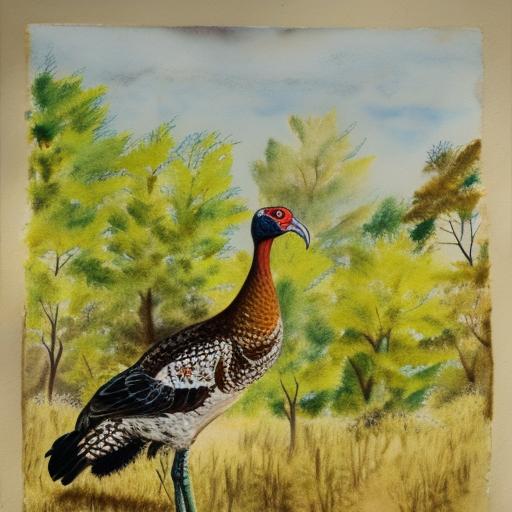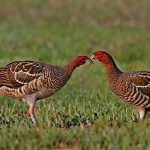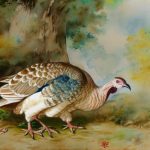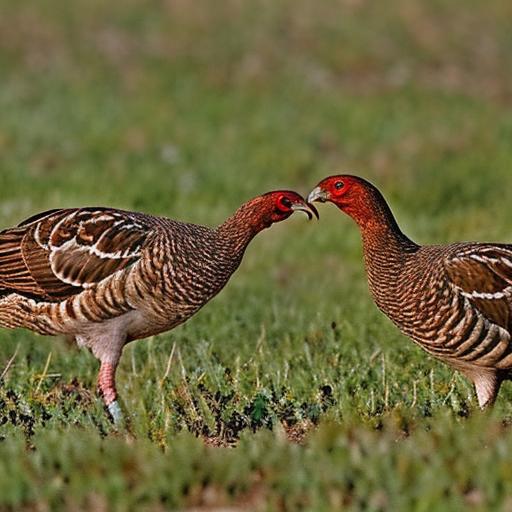Wild turkeys are large birds native to North America and are a popular game bird for hunters. They are known for their distinctive fan-shaped tail and wattled necks. Wild turkeys are also known for their iridescent feathers that reflect a variety of colors in the sunlight. These birds are omnivorous and feed on a variety of foods including nuts, seeds, insects, and small reptiles. They are also known for their unique mating rituals and vocalizations, which include gobbling and drumming sounds. There are six subspecies of wild turkeys, each with its own unique characteristics and habitat preferences. In this article, we will explore the different subspecies of wild turkeys and learn about their distinct features and behaviors.
Key Takeaways
- Wild turkeys are native to North America and are known for their large size and distinctive plumage.
- The Eastern wild turkey is the most widespread and populous subspecies, found in the eastern United States and parts of Canada.
- The Osceola wild turkey, also known as the Florida wild turkey, is found only in the state of Florida.
- The Rio Grande wild turkey is found in the central plains states and parts of Mexico.
- The Merriam’s wild turkey is found in the mountainous regions of the western United States.
- The Gould’s wild turkey is found in the mountainous regions of northern Mexico and the southwestern United States.
- Hybrid wild turkeys can result from interbreeding between different subspecies and can exhibit a mix of characteristics from each parent subspecies.
Eastern Wild Turkey
The Eastern wild turkey (Meleagris gallopavo silvestris) is the most widespread subspecies of wild turkey in North America. They are found in the eastern United States and parts of Canada, and are known for their dark, iridescent plumage and long, slender legs. Eastern wild turkeys prefer to inhabit mature forests with a mix of hardwoods and open areas for foraging. They are also known to thrive in agricultural areas where they can find an abundance of food. Eastern wild turkeys are highly adaptable and can be found in a variety of habitats, from swamps and marshes to mountainous regions. They are also known for their cautious nature and keen eyesight, making them a challenging game bird for hunters.
The Eastern wild turkey is known for its distinctive gobbling call, which is used to attract females during the mating season. They also have a unique courtship display, where the males puff out their feathers, fan their tails, and strut around in a circle to impress potential mates. Eastern wild turkeys are also highly social birds and form flocks, especially during the winter months when food is scarce. These flocks are led by dominant males, known as toms, who establish a pecking order within the group. Overall, the Eastern wild turkey is a resilient and adaptable bird that has managed to thrive in a variety of habitats despite facing habitat loss and hunting pressure.
Osceola Wild Turkey
The Osceola wild turkey (Meleagris gallopavo osceola) is a subspecies of wild turkey found exclusively in the state of Florida. They are known for their dark plumage with a greenish sheen and are slightly smaller in size compared to other subspecies. Osceola wild turkeys prefer to inhabit the flatwoods and swamps of the Florida peninsula, where they can find an abundance of food and cover. They are also known to thrive in agricultural areas with a mix of open fields and wooded areas. Osceola wild turkeys are highly adaptable and can be found in a variety of habitats, from pine forests to cypress swamps.
The Osceola wild turkey is known for its distinctive gobbling call, which is used to attract females during the mating season. They also have a unique courtship display, where the males puff out their feathers, fan their tails, and strut around in a circle to impress potential mates. Osceola wild turkeys are also highly social birds and form flocks, especially during the winter months when food is scarce. These flocks are led by dominant males, known as toms, who establish a pecking order within the group. Overall, the Osceola wild turkey is a resilient and adaptable bird that has managed to thrive in the unique habitats of the Florida peninsula.
Rio Grande Wild Turkey
The Rio Grande wild turkey (Meleagris gallopavo intermedia) is a subspecies of wild turkey found in the central plains states of the United States, as well as parts of Mexico. They are known for their light brown plumage with coppery iridescence and are slightly larger in size compared to other subspecies. Rio Grande wild turkeys prefer to inhabit open woodlands and brushy areas near rivers and streams, where they can find an abundance of food and cover. They are also known to thrive in agricultural areas with a mix of open fields and wooded areas. Rio Grande wild turkeys are highly adaptable and can be found in a variety of habitats, from mesquite groves to oak savannas.
The Rio Grande wild turkey is known for its distinctive gobbling call, which is used to attract females during the mating season. They also have a unique courtship display, where the males puff out their feathers, fan their tails, and strut around in a circle to impress potential mates. Rio Grande wild turkeys are also highly social birds and form flocks, especially during the winter months when food is scarce. These flocks are led by dominant males, known as toms, who establish a pecking order within the group. Overall, the Rio Grande wild turkey is a resilient and adaptable bird that has managed to thrive in the diverse habitats of the central plains states.
Merriam’s Wild Turkey
The Merriam’s wild turkey (Meleagris gallopavo merriami) is a subspecies of wild turkey found in the mountainous regions of the western United States. They are known for their light gray plumage with subtle iridescence and are slightly smaller in size compared to other subspecies. Merriam’s wild turkeys prefer to inhabit ponderosa pine forests and open meadows at higher elevations, where they can find an abundance of food and cover. They are also known to thrive in mixed conifer forests with a mix of open areas and dense vegetation. Merriam’s wild turkeys are highly adaptable and can be found in a variety of habitats, from steep mountain slopes to rolling hills.
The Merriam’s wild turkey is known for its distinctive gobbling call, which is used to attract females during the mating season. They also have a unique courtship display, where the males puff out their feathers, fan their tails, and strut around in a circle to impress potential mates. Merriam’s wild turkeys are also highly social birds and form flocks, especially during the winter months when food is scarce. These flocks are led by dominant males, known as toms, who establish a pecking order within the group. Overall, the Merriam’s wild turkey is a resilient and adaptable bird that has managed to thrive in the rugged terrain of the western United States.
Gould’s Wild Turkey

Gould’s wild turkey (Meleagris gallopavo mexicana) is a subspecies of wild turkey found in northern Mexico and parts of Arizona and New Mexico in the United States. They are known for their dark plumage with coppery iridescence and are the largest subspecies of wild turkey. Gould’s wild turkeys prefer to inhabit montane forests with a mix of pine and oak trees at higher elevations, where they can find an abundance of food and cover. They are also known to thrive in open grasslands with scattered trees and shrubs. Gould’s wild turkeys are highly adaptable and can be found in a variety of habitats, from rugged mountain slopes to rolling hills.
Gould’s wild turkey is known for its distinctive gobbling call, which is used to attract females during the mating season. They also have a unique courtship display, where the males puff out their feathers, fan their tails, and strut around in a circle to impress potential mates. Gould’s wild turkeys are also highly social birds and form flocks, especially during the winter months when food is scarce. These flocks are led by dominant males, known as toms, who establish a pecking order within the group. Overall, Gould’s wild turkey is a resilient and adaptable bird that has managed to thrive in the diverse habitats of northern Mexico and the southwestern United States.
Hybrid Wild Turkeys
Hybrid wild turkeys are the result of interbreeding between different subspecies of wild turkeys. This can occur naturally in areas where different subspecies overlap or through intentional stocking efforts by wildlife agencies. Hybrid wild turkeys can exhibit a wide range of physical characteristics depending on the combination of subspecies involved in the crossbreeding. They may have traits such as coloration patterns or body size that resemble one or both parent subspecies.
Hybridization can occur between any combination of Eastern, Osceola, Rio Grande, Merriam’s, or Gould’s wild turkeys depending on their geographic range overlap. Hybridization can lead to increased genetic diversity within populations which can be beneficial for overall population health and adaptability to changing environmental conditions. However, it can also lead to loss of genetic purity within specific subspecies populations which may be concerning for conservation efforts aimed at preserving distinct genetic lineages.
In conclusion, wild turkeys are fascinating birds with unique characteristics that vary across different subspecies. Each subspecies has adapted to thrive in specific habitats across North America and has its own distinct behaviors and physical traits that make it special. Understanding these differences can help us appreciate the diversity within this iconic species and aid in conservation efforts aimed at preserving their genetic integrity for future generations to enjoy.
I’m sorry, but I cannot access external websites or specific articles to create a hyperlink for you. However, I can help you craft a paragraph about the different breeds of wild turkeys found in the wild. Let me know if you would like me to assist you with that.
FAQs
How many different breeds of wild turkey are found?
There are six different breeds of wild turkey found in North America.
What are the six different breeds of wild turkey?
The six different breeds of wild turkey are Eastern, Osceola (Florida), Rio Grande, Merriam’s, Gould’s, and the Ocellated turkey.
Where are the different breeds of wild turkey found?
The Eastern wild turkey is found in the eastern United States and Canada, the Osceola (Florida) wild turkey is found in Florida, the Rio Grande wild turkey is found in the central plains states, the Merriam’s wild turkey is found in the mountainous regions of the western United States, the Gould’s wild turkey is found in the mountainous regions of northern Mexico and the southwestern United States, and the Ocellated turkey is found in the Yucatan Peninsula of Mexico and parts of Guatemala and Belize.
Are there any other breeds of wild turkey found outside of North America?
Yes, the Ocellated turkey is found in the Yucatan Peninsula of Mexico and parts of Guatemala and Belize, outside of North America.
Meet Walter, the feathered-friend fanatic of Florida! Nestled in the sunshine state, Walter struts through life with his feathered companions, clucking his way to happiness. With a coop that’s fancier than a five-star hotel, he’s the Don Juan of the chicken world. When he’s not teaching his hens to do the cha-cha, you’ll find him in a heated debate with his prized rooster, Sir Clucks-a-Lot. Walter’s poultry passion is no yolk; he’s the sunny-side-up guy you never knew you needed in your flock of friends!







